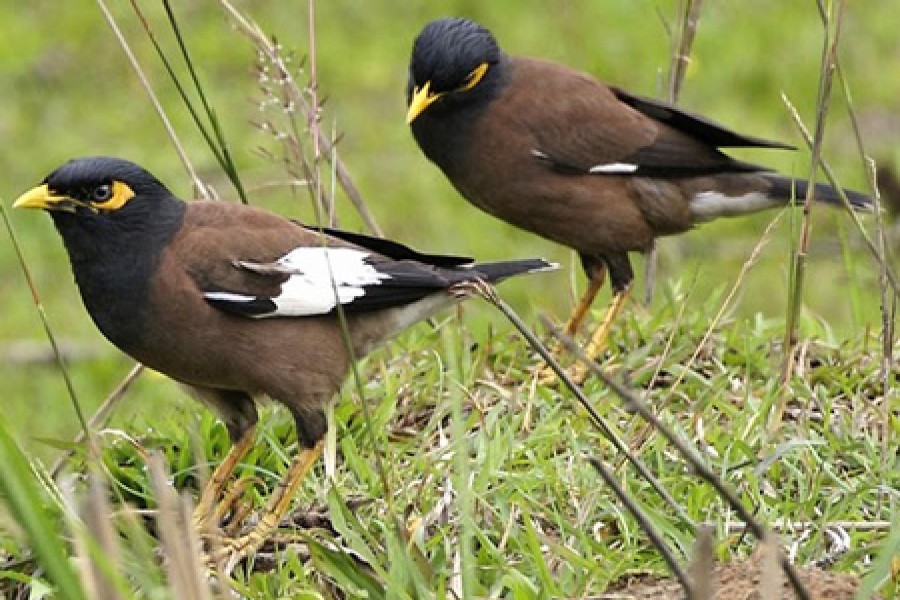
Published :
Updated :

Does a bird ever comes calling you? Most probably not. Dwijendranath Thakur, Rabindranath's eldest brother, an eyewitness once wrote, used to sit on a chair in the veranda of his house in Shantiniketan during the winter when a wild shalik or a common myna came flying to sit on his shoulder, head before flying back into the bush. Indeed birds can instinctively realise who their friends are and who are not. Even a crow, the smartest bird around, will come close to you or even make no attempt to fly if you are forgetful of its existence nearby and are deeply engrossed in some thoughts of yours. But if it can sense that you will not spare it if you can catch hold of it, the bird will snatch an abandoned piece of food nearer you with the utmost caution remaining all the while on its guard.
People take birds as pets. Whether it is justifiable or not is a debatable issue. Howevermuch one can argue in favour of keeping birds as pets, the fact is the winged friends are deprived of their free movements and territorial sense. Should it be done to a creature that was born to spread or flap its wings in the void to soar and glide majestically! In childhood, though, no such thought occurs to a boy and girl when the wonder that a bird is simply captures his/her imagination so much so that parents have to give in to their demands for procuring one or a few caged birds.
In a village, parents are hardly so doting and at times would not tolerate the luxury of spending so much time with a pet bird. There are however parents who do not mind their young ones taking birds for pets. They are lucky children. For one who is not so lucky but still procures a chick of jhuti shalik or jungle myna, not the larger myna proper, it is a continuous struggle. Usually this species of birds eats many things starting from corn to mixed boiled rice and milk to grasshopper. It is not an easy task to catch a large number of grasshoppers these days. But once when modern agriculture did not take over the traditional type and grasslands were available for feeding cattle, grasshoppers were in abundant supply. There is a technique to catch grasshoppers. Bare hands are enough to do the trick but you have to be smart enough. Just disturb a few grasses pulling their long leaves, the usually invisible winged insects would now start jumping to the next suitable plant. Now you see those and proceeding cautiously with a fast swipe of your hands catch those in your palms. If you can persuade a few of your friends to accompany you, your catch will be a couple days' feed for your winged friend.
The experience of taking such a chick can be mixed. Brought as a hatchling, it has to be fed almost continuously. A boy is supposed to feed such a chick more than its parents could do in the wild. Feeding helps it grow quickly. It has to be bathed with turmeric paste and water regularly. But alas a moment's lack of caution can cost you the life of the bird. A cat can lie in wait or a raven, a shalik chic's greatest enemy, will swoop on an orphaned chick yet to learn how to fly cleverly. Sometimes the chick, when considerably grown up, will not miss escaping your grip or the door of the cage left open unwittingly. But mostly for its death. Ravens are always there.
Only one known case can be presented to show how a bird does not forget its human friend. A bird let lose by a boy's father was missing for weeks. The boy was sad for a few days and then lost all hopes of getting it back. On a day in the month of Ashar, the boy was looking for small fish in the crystal clear water that inundated the lower banks of a pond. He had a friend with him.
Suddenly a large flock of jhuti shalik flew past and settled on a nearby rain tree. Wonder of wonders, one member of the flock decided otherwise. It stopped short of going there and started circling overhead to come down to perch on the head of the boy. The two friends had a happy reunion after weeks.
That boy is now an old man with no love lost for birds. Another wild bird now visiting the locality of city where now he lives in has captured his imagination. For the first few days in the month of Jyastha the bird announced its presence by cooing copiously usually between 9:00-10:00 in the morning. The man looked for it but in the thick branches of a mango tree, it was not visible. But suddenly one day, it came to the nearest mango tree where leaves are not very thick. The tiny cute bird calls hoop, hoop for about a minute or so, stops and then begins again. After a while it flies away. For a few days it came to visit there routinely. With black, white and red rings on both sides of its head, it is a shade paler than parrot. An internet search was not enough to find one like it. The bird still visits there and coos. Is this a bird calling a man!


 For all latest news, follow The Financial Express Google News channel.
For all latest news, follow The Financial Express Google News channel.